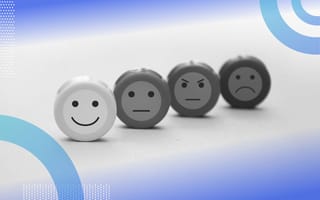Designing for emotions might not be the first thing product creators think of when crafting new products, but emotions play a tremendous role in user experience. People are both rational and emotional, and when they evaluate a specific product, they think about the values that it provides (rational thinking) and the emotions it conveys (emotional thinking).
A positive emotional response from using a product increases the chances of user retention. So, in this article, I will review the top three techniques that will help you create a positive emotional impact on your target audience.
Top 3 Emotional UX Techniques
- Find a perfect moment to surprise or delight users.
- Add bits of humor to the design.
- Humanize interaction with a product.
1. Find a Perfect Moment to Surprise or Delight Users
The Peak–End Rule states that people judge an experience primarily based on how they felt at its peak (i.e., its most intense point of their product journey) and at its end (when they stop using a product), rather than as a sum of all interactions they had. Intense points can be either positive (i.e., a moment of joy when a user achieves a significant goal) or negative (i.e., the sadness of losing daily progress due to an error in the app).
Product creators must think about the user journey holistically to identify peaks. It’s much easier to do that when you know what a user wants to achieve with your product. When you do, good design can help you reinforce the positive feeling of completing a goal. For example, when you design a fitness app and know that the user wants to lose weight, you can create a success state like a screen that the app shows when the user completes this goal that celebrates this achievement with the user. Just remember that the user shouldn’t expect this type of reinforcement. So, no need to tease that the app will show something when the user completes a goal because it will ruin the magic of the eventual moment for the user.
2. Add Bits of Humor to the Design
Humor is an integral part of our lives; it makes us feel human. By baking humor into a product you design, you can convey a certain mood and feelings. You can introduce humor in various areas of your app — text, illustrations, or animated effects, to name just three.
Just remember that the sense of humor you incorporate should be appropriate for your target audience. Using juvenile jokes in an app designed for senior adults can alienate users. In many cases, you can define what sort of humor is appropriate by writing a content style guide that explains voice and tone rules. MailChimp offers an excellent example of a clear content style guide for its product that other content writers can follow.
3. Humanize Interaction With a Product
Using a digital product shouldn’t feel like interacting with a robot. When you create more human interactions within a product, you give users the impression that they’re engaging with a human rather than a machine. This approach allows you to foster a much better connection between a product and its users so that people are more likely to use it again.
Many design techniques allow you to create a more natural interaction with a product. One of them, emotional reactions to user input, is familiar to many iOS users. Apple uses a simple animated effect (shaking) when the user enters an incorrect password. Despite the relative simplicity effect, it creates a significant impression on users. This effect resembles the head-shaking movement people use when they want to say “No.” The magic of this effect is that it doesn’t require any error text; most users easily decode its meaning.
Another interesting idea can be introducing elements that mimic human facial expressions in the UI. Humans communicate lots of information non-verbally. We use body language and facial expressions to help others understand our feelings. Why not use the same approach in the products we design? For example, when we ask users to rate their experience from one (Poor) to five (Excellent), we should add an animated face in the UI. The facial expression should change depending on what the user chooses from a sad face when the user selects one to super excited when the user chooses five.
Speaking of graphic elements, we can introduce a mascot, a symbolic figure representing the product, in the user interface. Mascots can serve purely decorative purposes (i.e., making mascots a part of their logo), or they can be used as active participants in user interactions. The second approach is more valuable because mascots guide the user in interacting with a product. Users don’t feel like they’re interacting with the pure functionalities of a product; they think instead they’re interacting with a character with personality. Duolingo is one good example of an app that follows this strategy.
So far, we’ve discussed a few solutions for the graphical user interface. What about other interaction media, such as voice? Suppose you design products that support voice-based interactions, such as smart assistants. In this case, you have a unique opportunity to play with the voice of your assistant to create the right impression on your target audience. The magic of voice-based interactions is that even if we don’t see the person to whom we’re talking, we can picture how this person looks in our head. And we do it just by hearing the voice alone. Playing with intonation and tone of voice will help you achieve outstanding results. No wonder so many Amazon Alexa users have romantic feelings for their smart assistant.
Embrace Emotion in Design
Good functionality and usability are no longer enough properties of good product design. It’s time to design products that will spark positive emotional responses in the hearts of our users. Design is all about communication, and it’s possible to communicate positive vibes using our products. These techniques will help you with that.





